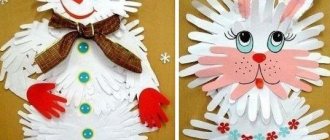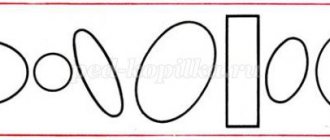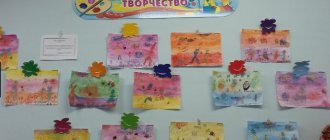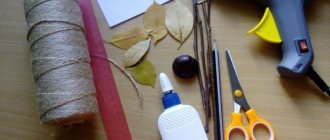Theater. Projects - Short-term project “We are fantasy actors! Noise Theater" for children 6–7 years old
Publication “Short-term project “We are fantasy actors! Noise theater" for children..." Municipal budgetary educational institution "Kindergarten No. 1 of Svetogorsk" PROJECT "We are actors - dreamers" (group No. 11 "Ants") Project participants: Nechaeva T.G - musical director Novikova N.V. teacher Lukina T.V - teacher Krasnova O.A - instructor...
Project of a theatrical production of the musical fairy tale-opera "Kolobok" - senior preschool age. 2022 Dokukina M. N Municipal autonomous preschool educational institution kindergarten "Teremok" Project of a theatrical production of the musical fairy tale - the opera "Kolobok". (senior preschool age) Developed by: music director Dokukina M.N. 2022 1. Relevance, problem...
Project in the preparatory group “Theater through the eyes of children”
Project passport Project type: creative. Project participants: teacher, preschool children, parents of students. Project implementation period: June 2022; short. Relevance: Intensive change in our lives, active penetration...
Project for preschool children 5–7 years old “The Magical World of Theater” Project passport It gives lessons in beauty, morality and ethics. And the richer they are, the more successful the development of the spiritual world of children..." B. M. Teplov Goal: To organize the implementation of these tasks through all types of children's activities aimed at developing creative in children...
Theatrical classes in kindergarten outline of a drawing lesson (senior group) on the topic
Municipal state preschool educational institution
"Kindergarten No. 229" compensatory type
Summary of an integrated lesson in visual arts for children of senior preschool age “making a poster for the premiere of the play”
Performed:
Miller
Tatyana Alekseevna
Novokuznetsk
2013
Software tasks.
- Introduce children to the concept of “poster”, a schematic sketch of the composition of the poster.
- Combine different types of inventive activities of children to perform joint work.
- Form the idea that the overall result depends on the work of everyone.
- Activation of the dictionary: poster, sketch, premiere.
Materials and equipment: sample poster, sketch of the poster, 5 photographs of children participating in the fairy tale, 5 stencils of the fairy tale characters, letter templates, paints, pencils, felt-tip pens for drawing the characters’ figures; scissors, glue, napkins, a sheet of Whatman paper.
Progress of the lesson.
The teacher seats the children in subgroups (5 people each) at tables with prepared material.
— Soon the premiere of the fairy tale “Cat’s House” will take place in our kindergarten. Who knows what a “premiere” is? (children's answers)
— How can viewers find out which fairy tale they will watch, on what day and time? How do you find out when theater tickets are distributed? (children's answers)
(If the children themselves say that there is such a way of informing viewers as a poster, then the teacher continues the thought. If the children find it difficult, then the teacher begins work by showing a sample poster, i.e. introduces the children to the features of the poster).
“The brighter and more interesting the poster is, the more people will notice and read it and, of course, want to watch the fairy tale.”
“Let’s all make a poster for our theater today.” So that you know what our poster will look like, I will show you a sketch of it. A poster sketch is a diagram of how the inscriptions and drawings of the poster will be located.
(Shows the children the sketch and gives them time to familiarize themselves.)
-What did you learn from this sketch? What do you think will be shown in the middle of the poster? (inscription). What will happen around? (portraits of artists with completed figures of fairy tale characters).
- Today you will each do your own work. But when you and I combine the results together, we will get one piece of work - a theater poster. To make the poster colorful and bright, everyone must do their part, how? Of course, carefully, without rushing and always to the end.
- Look at what material is on your table, and from it you will find out what each group will do for the poster.
(It is once again clarified what each subgroup of children will do. Then they are asked to start working.)
Methodical instructions.
As they work, children cutting out portraits from photographs are given advice on how to cut out carefully and so that the face is completely exposed. Paste the photo in the location indicated on the sheet.
Other children are given advice on how to cut out and paint a figure for the portrait of the “artist”.
Children working with letter templates are reminded to trace the letters very accurately, right at the edge, holding the pencil vertical to the paper. Then carefully cut along the line with scissors.
When everything is ready for decoration, two tables are moved, a sheet of whatman paper is placed, and according to the sketch, the teacher, together with the children, places all the figures and letters.
It is better to start designing a poster by gluing figures, then portraits to the figures, and then letters. The teacher helps children distribute work among themselves using directions, counting rhymes and other techniques.
In conclusion, they examine the poster and discuss whether it can attract the attention of parents and children (children’s opinions are listened to, with the obligatory recording of the words “poster”, “premiere” in their answers).
Progress of the lesson:
Children are included in the group. Pictures depicting a fox, a hare and a rooster are hung on the flannelgraph.
- Hello guys. the theater again . Look at the board, who do you see?
Guys, are the fox and the hare wild animals or domestic ones? Is a cockerel an animal or a bird? That's right - it's poultry. Guys, despite the fact that these animals are so different, they still met in the same fairy tale. Now I’ll start telling you this fairy tale, and you try to guess what it’s called? That's right "Zayushkina's hut"
.
Guys, this week we are all invited to a performance based on this fairy tale. Remind me what the audience must have to get into the auditorium? (
tickets ) .
Of course tickets . But the trouble is, the box office has already closed and now you can’t get tickets . How to be? How else can we get tickets ? (
draw ) .
That's right, before we start drawing , let's play.
Physical education lesson: Fox walks across the bridge - Children stomp their feet
Carrying a bundle of brushwood - They pretend to carry a weight on their back
- Heat the stove - Movement of hands from side to side
— Cook dinner — Circular movements with hands
— Feed guests — Bend forward
And the bear come, and the wolf come, and the hare come, and the rooster come!
- Oh please! - end of the game.
- What a hospitable Fox!
Now let's go to the tables and take care of our tickets . (Children sit down)
.
Guys, what are we going to draw ? Of course, we will draw our fairy-tale heroes on them. Someone will draw a bunny, someone a fox, and someone a cockerel, and someone might want to draw them all together ? Let's get to work, and don't forget that our animals should be the same color as they actually are. (children draw)
.
Wow, well done guys, what beautiful and bright tickets we got . I think that there will be many guests in our theater . Well, I'm waiting for you at the performance!
Unconventional drawing techniques in kindergarten. Summary of an open lesson in the middle group Summary of an open lesson on drawing in the middle group using the non-traditional poking method Purpose: to teach children to poke with a hard semi-dry brush.
Planning classes for a circle on artistic creativity in the early age group “Funny Fingers” Circle “Funny Fingers” Objectives: To introduce young children to unconventional methods of drawing; Develop.
Preparatory group. Senior preschool age. Children 6-7 years old
Long-term project in the preparatory group “Theater Palette” Project : “ Theater Palette ”
(socialization of preschool children through interaction with family, society through
theatrical activities ) Type of project : creative, long-term, group Nature of contacts: children of a preschool educational institution, society or...
Project “The Magical World of Theater” for children 5–6 years old 1. INTRODUCTION. 2. RELEVANCE OF CREATION OF THE PROJECT . Modernity dictates its conditions in the development of children; in the age of information and computerization, classical methods in raising children are forgotten. Insufficient attention to theater as a means of raising children, superficial knowledge...




